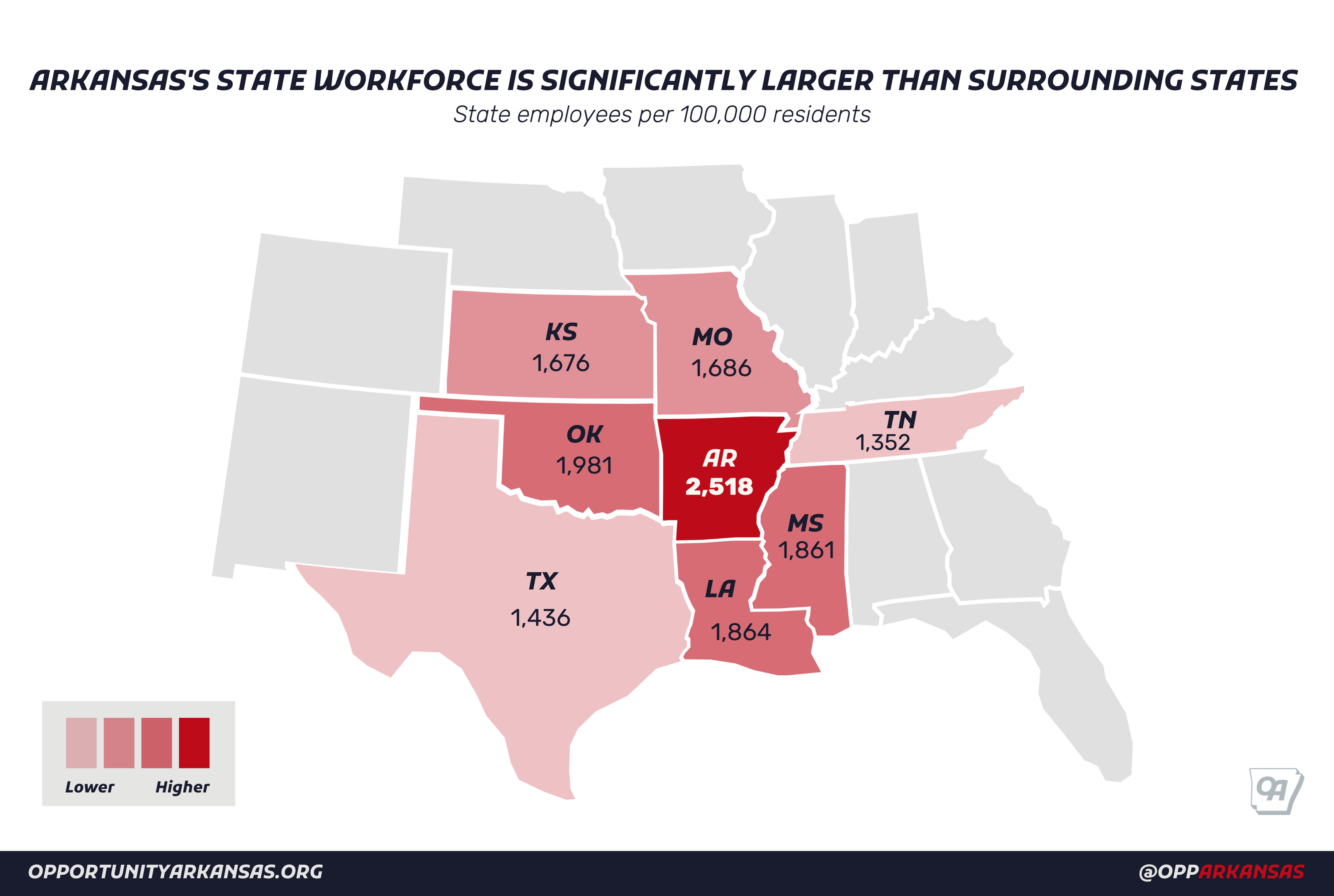The size of Arkansas’s state government workforce is absolutely out of control. This picture becomes even clearer, and more alarming, when comparing Arkansas’s workforce to neighboring states.
The state of Arkansas currently has more than 76,000 state employees, or 2,518 state employees per 100,000 residents. After declining briefly at the beginning of the COVID-19 pandemic, the numbers have been climbing again, and to levels that are dramatically higher than all neighboring states.
The next highest state (Oklahoma) has less than 2,000 state workers per 100,000 residents.
Tennessee and Texas, both neighboring states without income taxes, have roughly half the number of state employees Arkansas does per 100,000 residents.
Perhaps it’s no wonder then that they can afford to not punish workers in their states with an income tax.

Clearly, something is out of whack. If Mississippi can get by with just 1,800 state employees per 100,00 residents, why can’t Arkansas?
Especially if Arkansas policymakers are serious about eliminating the state income tax, and they should be, the hard work begins now to rein in the scope and size of state government.
And there are several effective, proven strategies to do just that, without layoffs or mass firings of state workers.
Some states have pursued reduced workforce savings by closing positions (Florida). Other states (Kansas) have used an all-of-the-above strategy that involved reducing positions, consolidating agencies, and privatizing some services. Over a period of just 14 years, Kansas saw a 25 percent reduction in the state workforce.
But the simplest, and perhaps most viable, strategy comes from right here in the Natural State, when Governor Asa Hutchinson took the helm of state government in 2015.
The Hutchinson Strategy: Require gubernatorial approval of new hires
Governor Hutchinson implemented a hiring freeze in 2015. Agency heads could only hire employees after receiving permission directly from governor. As it turns out, this was a very effective strategy for reducing the size of the state workforce, and quickly.
In the first six months of the hiring freeze, the state saved $2.5 million in salaries through a reduction in the number of state employees by 297.
By April of 2017, the hiring freeze had eliminated 1,400 positions that would have otherwise cost taxpayers approximately $41 million annually.
(Unfortunately, the hiring freeze was largely rescinded by August of 2017.)
This type of accountability between the governor’s office and the agencies is vital: without it, positions will be filled before the state’s chief executive even knows they were vacant. And reining in the size of state government will become virtually impossible.
3 Ways to Responsibly Reduce the Size of Arkansas’ State Workforce
In Arkansas, public sector employees can be terminated at any reason or for no reason at all (with the exception of certain civil service employees). This gives the governor tremendous leverage in controlling the size of the state employee workforce: Through budget proposals and in working with agency heads, the governor can directly influence the size and scope of Arkansas state government.
Below are four strategies to consider to reduce the size of the Arkansas workforce, many of which can be combined for maximum effect and savings for hard-working Arkansas taxpayers.
1. Reinstate hiring accountability.
A hiring freeze can gradually shrink the size of the public sector workforce with minimal disruption. By requiring all requests for new personnel to be approved by the Governor’s Office, the administration can reduce the size of the state workforce over time while still allowing necessary flexibility for essential state positions to be filled.
2. Cap salaries of high-paying state government positions.
There are currently 269 positions in Arkansas state government that pay more than the governor’s annual salary. If Arkansas were to cap these salaries at the governor’s salary, it would save nearly $6.4 million in the current fiscal year alone. Additionally, these salary reductions would inevitably encourage certain high-paying bureaucrats to leave their positions voluntarily, opening up opportunities for vacancy savings or the potential to re-hire for the same position at a more reasonable rate of pay.
3. Reduce the state workforce by 25 percent.
At more than 76,000 state employees, Arkansas has far more public sector employees per capita than other states, including the neighboring state of Tennessee.
If Arkansas were to cut 25 percent of its state workforce (excluding higher education), or more than 7,500 workers, over a two-year budget cycle, it could generate nearly $400 million in annualized savings while reducing the size of government.
(Even with this level of a reduction, Arkansas would still have more state workers per 100,000 residents than Tennessee.)
Ultimately, if state policymakers hope to make good on their promises to eliminate the state income tax, reining in the massive state bureaucracy must be part of that equation. Simply waiting on revenue growth to out pace the income tax will take decades.
Arkansans need tax relief now, especially in this period of record inflation, and hiring accountability is a huge part of making that a reality.


